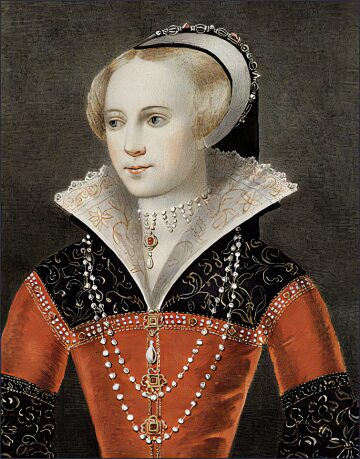We’ve all been there, ladies: that harrowing trek home after a wild night. You’re hungover. Your heels are killing you. Your eye makeup is smeared. But at least you’re not half-naked getting booed in the town square. That’s what happened to Jane Shore, the mistress of King Edward IV, who walked the original walk of shame.
Videos by Rare
A (loose) theatrical reenactment even featured on Game of Thrones.
Jane Shore

King Edward IV reigned over England twice, from 1461 to 1470 and from 1471 to 1483, struggling for power against his rival King Henry VI. His rule was marred by political threat from Henry’s line — the Wars of the Roses — but there was even more medieval drama behind the scenes. Edward had many, many mistresses.
The most famous among them? Jane Shore.
Edward was a notoriously horny king. He scandalized the country when he married Elizabeth Woodville, a widowed commoner, in 1464. Though Woodville brought no estate or political ties to the marriage, she was beautiful. And that’s what mattered to Edward. Woodville had two children from her previous marriage and more Edward ten more, in all.
But that did not stop Edward from pursuing Jane Shore. Born with the name Elizabeth Lambert, Shore was the daughter of a wealthy merchant. According to the 1933 biography The Witchery of Jane Shore, the Rose of London: The Romance of a Royal Mistress, Jane spent time as a child watching the courtly ladies who would frequent her father’s shop. Copying their behavior, Jane set herself apart as a desirable prospect for high-ranking British suitors. They included Baron William Hastings, an advisor of Edward IV, who remained close to Jane throughout her life.
However, Jane was married off to an older banker, William Shore… and when their marriage was annulled in 1476, Jane set her sights on the king.
Unlike his many other mistresses, Edward doted on Shore. She held some real sway over her lover, which she used to help gain pardons for various prisoners. Records also show that Edward did not “shower” Jane with gifts like he did with the other girls; their relationship appeared more personal and emotional. She remained with Edward until his death in 1483.
But Jane would pay a price for that. After Edward’s death, King Richard III ascended to the throne and charged several of Edward’s confidantes with conspiracy. Jane had become involved with Edward’s stepson Thomas Grey (Woodville’s biological son) who married Hastings’ stepdaughter Cecily Bonville. And Jane was instrumental in that coupling. Still close with Hastings, Jane helped to solidify the alliance between his house and the widowed queen’s — which Richard perceived as a threat to his reign.
Jane was accused of passing messages between Hastings and Woodville, and all three parties were charged with conspiracy by the new king. Hastings was executed while Jane was sentenced to the walk of shame.
Jane’s Walk of Shame

Though the punishment was politically motivated, Jane Shore was technically sentenced for promiscuity and made to repent at Paul’s Cross, an outdoor pulpit in London. Dressed only in her chemise, basically an undergarment smock, Shore was then paraded through the streets barefoot and holding a taper. But King Richard III’s plan may have backfired.
Townspeople definitely gawked at Shore – but not for the intended reason. Apparently, all the men in town were taken with Shore’s beauty. She also retained her composure throughout the walk, not buckling to the shame. The eventual saint Sir Thomas More, who witnessed the walk, said Richard’s plan had backfired: “Went she so fair and lovely … that her great shame wan her much praise.”
That charm stayed with Jane, even into her imprisonment. After the public penance, she was sentenced to to Ludgate Prison where Thomas Lynom, the King’s Solicitor, fell head over heels for his ward. He fought to free her and eventually did. They married and, according to the biographer Thomas More, Shore was still beautiful when she died in 1527 at age 82.
On ‘Game of Thrones’
Many theatrical takes on Jane Shore have appeared over the centuries. But the most famous is a more modern interpretation.
In Game of Thrones, the disgraced queen Cersei Lannister is paraded through the streets of King’s Landing naked, pelted by stones — and worse. “Shame, shame, shame,” the onlookers cry. In the show, Cersei is repenting for many crimes, including incest and murder.
Game of Thrones author George R.R. Martin has been open about his inspiration for the scene. Speaking to Entertainment Weekly about the scene from his book, Martin said:
“That was an interesting chapter to write, and based on actual medieval events. Jane Shore, mistress of King Edward IV, was punished that way after Edward died. It’s going to be a controversial scene when it comes out — is it misogynistic or feminist? It wasn’t a punishment ever inflicted on men. It was a punishment directed at women to break their pride. And Cersei is defined by her pride.”
— George R.R. Martin in Entertainment Weekly
Certainly, Martin is right that the walk aimed to strip women of their pride. But according to most historic accounts, Shore actually maintained her pride through that awful parade.
Of course, today, the walk of shame has a very different, very post-coital, connotation. But that doesn’t mean you can’t be proud. Check out Amber Rose‘s comedic take on the morning-after tradition, below:



